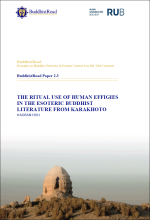BuddhistRoad Paper 2.3 "The Ritual Use of Human Effigies in the Esoteric Buddhist Literature from Karakhoto"
Synopsis
Among the Tibetan Buddhist literature unearthed at Karakhoto, a number of ritual texts of the liṅga effigies have recently been identified. These texts describe how to make and use the liṅga effigies for ritual purposes such as healing, inflicting harm, and exorcism. The rituals involving the use of the liṅga effigies had their origin in India, passed through Tibet, and spread to the Tangut Empire (ca. 1038–1227, in Chinese sources known as Xixia 西夏) and into the Yuan Dynasty (1271–1368, 元). So far, not much is known about the performance and transmission of the liṅga rituals in Eastern Central Asia. To fill this gap, this paper translates and annotates the ritual texts from the Karakhoto documents and in doing so illustrates how the liṅga effigies were made and used by people at the time, and further explores their transmission across Eastern Central Asia between the 11th and 14th centuries.
Chinese Translation
在黑水城出土的藏传佛教文献中, 有一些关于替身(liṅga effigies)的仪轨文本. 这些文献描述了如何制作和使用“人偶 (liṅga) ”, 以达到治疗, 伤害和驱魔等仪轨的目的. 使用“人偶”的仪轨起源于印度, 经过西藏, 传播到西夏(约公元1038–1227年)和元朝(公元1271–1368年). 到目前为止, 对中亚东部地区“人偶”仪轨的使用和传播的研究阙如. 为了填补这一空白, 本文对黑水城文献中的仪轨文本进行了翻译和注释, 从而说明当时人们是如何制作和使用“人偶”的, 并进一步探讨了它们在11–14世纪期间在中亚东部的传播情况.

Downloads
Published
Categories
License

This work is licensed under a Creative Commons Attribution-NonCommercial-NoDerivatives 4.0 International License.

